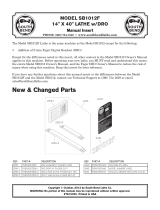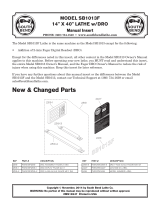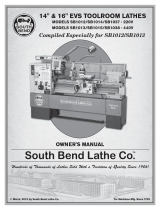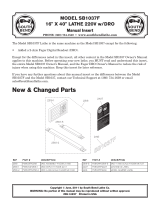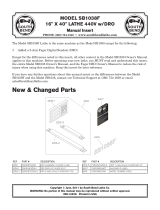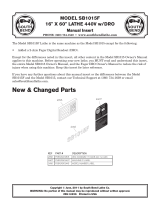Page is loading ...

Operating Instructions
GH-1340W/1440W
Geared Head Lathes
See manual no. M-321810-1 for service parts and electrical diagrams.
WALTER MEIER (Manufacturing) Inc.
427 New Sanford Road
LaVergne, Tennessee 37086 Part No. M-321810
Ph.: 800-274-6848 Revision G 08/2010
www.waltermeier.com Copyright © 2010 Walter Meier (Manufacturing) Inc.
This .pdf document is bookmarked

2
Warranty and Service
Walter Meier (Manufacturing) Inc., warrants every product it sells. If one of our tools needs service or repair, one of
our Authorized Service Centers located throughout the United States can give you quick service. In most cases, any
of these Walter Meier Authorized Service Centers can authorize warranty repair, assist you in obtaining parts, or
perform routine maintenance and major repair on your JET
®
tools. For the name of an Authorized Service Center in
your area call 1-800-274-6848.
MORE INFORMATION
Walter Meier is consistently adding new products to the line. For complete, up-to-date product information, check with
your local Walter Meier distributor, or visit waltermeier.com.
WARRANTY
JET products carry a limited warranty which varies in duration based upon the product (MW = Metalworking, WW =
Woodworking).
WHAT IS COVERED?
This warranty covers any defects in workmanship or materials subject to the exceptions stated below. Cutting tools,
abrasives and other consumables are excluded from warranty coverage.
WHO IS COVERED?
This warranty covers only the initial purchaser of the product.
WHAT IS THE PERIOD OF COVERAGE?
The general JET warranty lasts for the time period specified in the product literature of each product.
WHAT IS NOT COVERED?
Five Year Warranties do not cover woodworking (WW) products used for commercial, industrial or educational
purposes. Woodworking products with Five Year Warranties that are used for commercial, industrial or education
purposes revert to a One Year Warranty. This warranty does not cover defects due directly or indirectly to misuse,
abuse, negligence or accidents, normal wear-and-tear, improper repair or alterations, or lack of maintenance.
HOW TO GET SERVICE
The product or part must be returned for examination, postage prepaid, to a location designated by us. For the name
of the location nearest you, please call 1-800-274-6848.
You must provide proof of initial purchase date and an explanation of the complaint must accompany the
merchandise. If our inspection discloses a defect, we will repair or replace the product, or refund the purchase price,
at our option. We will return the repaired product or replacement at our expense unless it is determined by us that
there is no defect, or that the defect resulted from causes not within the scope of our warranty in which case we will,
at your direction, dispose of or return the product. In the event you choose to have the product returned, you will be
responsible for the shipping and handling costs of the return.
HOW STATE LAW APPLIES
This warranty gives you specific legal rights; you may also have other rights which vary from state to state.
LIMITATIONS ON THIS WARRANTY
WALTER MEIER (MANUFACTURING) INC., LIMITS ALL IMPLIED WARRANTIES TO THE PERIOD OF THE
LIMITED WARRANTY FOR EACH PRODUCT. EXCEPT AS STATED HEREIN, ANY IMPLIED WARRANTIES OR
MERCHANTABILITY AND FITNESS ARE EXCLUDED. SOME STATES DO NOT ALLOW LIMITATIONS ON HOW
LONG THE IMPLIED WARRANTY LASTS, SO THE ABOVE LIMITATION MAY NOT APPLY TO YOU.
WALTER MEIER SHALL IN NO EVENT BE LIABLE FOR DEATH, INJURIES TO PERSONS OR PROPERTY, OR
FOR INCIDENTAL, CONTINGENT, SPECIAL, OR CONSEQUENTIAL DAMAGES ARISING FROM THE USE OF
OUR PRODUCTS. SOME STATES DO NOT ALLOW THE EXCLUSION OR LIMITATION OF INCIDENTAL OR
CONSEQUENTIAL DAMAGES, SO THE ABOVE LIMITATION OR EXCLUSION MAY NOT APPLY TO YOU.
Walter Meier sells through distributors only. The specifications in Walter Meier catalogs are given as general
information and are not binding. Members of Walter Meier reserve the right to effect at any time, without prior notice,
those alterations to parts, fittings, and accessory equipment which they may deem necessary for any reason
whatsoever. JET
®
branded products are not sold in Canada by Walter Meier.

3
Table of Contents
Warranty and Service .............................................................................................................................. 2
Table of Contents .................................................................................................................................... 3
Warning ................................................................................................................................................... 4
Specifications .......................................................................................................................................... 5
Uncrating ................................................................................................................................................. 6
Installation ............................................................................................................................................... 7
Chuck Preparation (Three Jaw) ............................................................................................................ 8
Lubrication............................................................................................................................................... 9
Coolant Preparation ............................................................................................................................... 11
Electrical Connections ........................................................................................................................... 11
General Description ............................................................................................................................... 12
Operation .............................................................................................................................................. 17
Feed and Thread Selection ................................................................................................................ 17
Change Gears Replacement .............................................................................................................. 17
Automatic Feed Operation and Feed Changes ................................................................................... 18
Powered Carriage Travel ................................................................................................................... 18
Thread Cutting ................................................................................................................................... 18
Compound Rest ................................................................................................................................. 19
Adjustments .......................................................................................................................................... 19
Saddle ............................................................................................................................................... 19
Cross Slide ........................................................................................................................................ 19
Compound Rest ................................................................................................................................. 19
Tailstock ............................................................................................................................................ 20
Tailstock Off-Set ................................................................................................................................ 20
Tailstock Gibs .................................................................................................................................... 20
Headstock Alignment ......................................................................................................................... 20
Removing Gap Section ...................................................................................................................... 21
Installing Removable Gap Section ...................................................................................................... 21
Belt Replacement and Adjustment...................................................................................................... 22
Aligning Tailstock to Headstock .......................................................................................................... 22
Metric Thread Table .............................................................................................................................. 23
Inch Lead and Feed Table ..................................................................................................................... 23
Cross Feed Table .................................................................................................................................. 23

4
Warning
Read and understand the entire instruction manual before attempting assembly or operation.
These lathes are designed and intended for use by properly trained and experienced personnel
only. If you are not familiar with the proper and safe operation of a lathe, do not use until proper
training and knowledge have been obtained.
1. Always wear approved safety glasses/face shields while using this machine.
2. Make certain the machine is properly grounded.
3. Before operating the machine, remove tie, rings, watches, other jewelry, and roll up sleeves above
the elbows. Remove all loose clothing and confine long hair. Do not wear gloves.
4. Keep the floor around the machine clean and free of scrap material, oil and grease.
5. Keep machine guards in place at all times when the machine is in use. If removed for maintenance
purposes, use extreme caution and replace the guards immediately.
6. Do not over reach. Maintain a balanced stance at all times so that you do not fall or lean against
blades or other moving parts.
7. Make all machine adjustments or maintenance with the machine unplugged from the power source.
8. Use the right tool. Don't force a tool or attachment to do a job for which it was not designed.
9. Replace warning labels if they become obscured or removed.
10. Make certain the main power switch is in the OFF position before connecting the machine to the
power supply.
11. Give your work undivided attention. Looking around, carrying on a conversation, and "horse-play" are
careless acts that can result in serious injury.
12. Keep visitors a safe distance from the work area.
13. Use recommended accessories; improper accessories may be hazardous.
14. Make a habit of checking to see that keys and adjusting wrenches are removed before turning on the
machine.
15. Never attempt any operation or adjustment if the procedure is not understood.
16. Keep fingers away from revolving parts and cutting tools while in operation.
17. Keep belt guard in place and in working order.
18. Never force the cutting action.
19. Do not attempt to adjust or remove tools during operation.
20. Always keep cutters sharp.
21. Always use identical replacement parts when servicing.
22. Never operate this machine under the influence of alcohol or drugs.
23. Failure to comply with all of these warnings may cause serious injury.
Familiarize yourself with the following safety notices used in this manual:
This means that if precautions are not heeded, it may result in minor injury and/or
possible machine damage.
This means that if precautions are not heeded, it may result in serious or even fatal
injury.

5
Specifications
GH-1340W-1 GH-1440W-1
GH-1340W-3 GH-1440W-3
Stock Number (1 Phase).................................................. 321810.................................................. 321830
Stock Number (3 Phase).................................................. 321820.................................................. 321840
Capacities:
Swing Over Bed (in.)................................................................ 13.......................................................... 14
Swing Over Cross Slide (in.) ................................................ 7-1/4...................................................... 8-1/4
Swing Through Gap (in.) .......................................................... 19.......................................................... 20
Length of Gap (in.) ............................................................... 9-3/8...................................................... 9-3/8
Distance Between Centers (in.) ............................................... 40.......................................................... 40
Headstock:
Hole Through Spindle (in.) ................................................... 1-1/2...................................................... 1-1/2
Spindle Nose ....................................................................... D1-4.......................................................D1-4
Taper in Spindle Nose ........................................................ MT-5...................................................... MT-5
Spindle Taper Adapter ........................................................ MT-3...................................................... MT-3
Spindle Bearing Type ..................................Taper Roller Bearing.............................. Taper Roller Bearing
Number of Spindle Speeds ...................................................... 12.......................................................... 12
Range of Spindle Speeds (RPM) .................................... 40-1800................................................. 40-1800
Gearbox:
Number of Longitudinal and Cross Feeds ................................ 40.......................................................... 40
Range of Longitudinal Feeds (inch/rev.) ............. 0.0011 – 0.0271..................................... 0.0011 – 0.0271
Range of Cross Feeds (inch/rev.) ...................... 0.0003 – 0.0100..................................... 0.0003 – 0.0103
Number of Inch Threads .......................................................... 40.......................................................... 40
Range of Inch Threads (T.P.I.) ......................................... 4 – 112.................................................. 4 – 112
Number of Metric Threads ....................................................... 22.......................................................... 22
Range of Metric Threads (mm) .................................... 0.45 – 7.5............................................... 0.45 – 7.5
Leadscrew (in.) ......................................................... 7/8 x 49-1/2............................................ 7/8 x 49-1/2
Feed Rod Diameter (in.) ......................................................... 3/4 ........................................................ 3/4
Compound and Carriage:
Toolpost Type....................................................................4-Way.................................................... 4-Way
Maximum Tool Size (in.) ................................................ 5/8 x 5/8................................................. 5/8 x 5/8
Maximum Compound Slide Travel (in.) ................................ 3-1/2...................................................... 3-1/2
Maximum Cross Slide Travel (in.) ........................................ 6-3/8...................................................... 6-3/8
Maximum Carriage Travel (in.) ........................................... 37-1/2.................................................... 37-1/2
Tailstock:
Tailstock Spindle Travel (in.) ................................................ 4-3/4...................................................... 4-3/4
Diameter of Tailstock Spindle (in.) ................................... 1-25/32.................................................. 1-25/32
Taper in Tailstock Spindle ................................................... MT-3...................................................... MT-3
Miscellaneous:
Steady Rest Capacity (in.) .......................................... 1/4 – 3-1/2............................................. 1/4 – 3-1/2
Follow Rest Capacity (in.) .......................................... 1/4 – 2-3/4............................................. 1/4 – 2-3/4
Length of Bed (in.) ............................................................. 54-1/2.................................................... 54-1/2
Width of Bed (in.) ............................................................... 10-1/4.................................................... 10-1/4
Height of Bed (in.).............................................................. 12-3/4.................................................... 12-3/4
Overall Dimensions (in.).................................... 78L x 38W x 59H................................... 78L x 38W x 59H
Main Motor (1-Phase) ................................ 3HP, 1PH, 230V Only............................ 3HP, 1PH, 230V Only
Main Motor (3-Phase) .......... 3HP, 3PH, 230/460V prewired 230V..... 3HP, 3PH, 230/460V, prewired 230V
Net Weight (lbs./approx.) .................................................... 2,081..................................................... 2,191
Shipping Weight (lbs./approx.) ............................................ 2,351..................................................... 2,491
The above specifications were current at the time this manual was published, but because of our policy of continuous
improvement, Walter Meier reserves the right to change specifications at any time and without prior notice, without
incurring obligations.

6
Uncrating
Open shipping crate and check for shipping
damage. Report any damage immediately to
your distributor and shipping agent. Do not
discard any shipping material until the Lathe is
assembled and running properly.
Compare the contents of your crate with the
following parts list to make sure all parts are
intact. Missing parts, if any, should be reported
to your distributor.
Read and understand the
entire contents of this manual before
attempting set-up or operation. Failure to
comply may cause serious injury!
Contents of the Shipping Container
(Figure 1)
1 Lathe
1 Steady Rest
1 Follow Rest
1 6" Three Jaw Chuck w/ Top Reversing Jaws
(Direct Mount)
1 8" Four Jaw Chuck with Backplate
1 12" Face Plate (strapped to container floor)
1 Backplate
1 Tool Box
Tool Box Contents:
1 No. 1 Cross Point Screwdriver
1 No. 1 Flat Blade Screwdriver
4 Open End Wrench
(9-11, 10-12, 12-14, 17-19mm)
6 Hex Socket Wrench (2.5, 3, 4, 5, 6, 8mm)
2 Shear Pin
1 30T Change Gear
1 32T Change Gear
2 40T Change Gear
1 Oil Can
2 No. 3 Morse Taper Dead Center
1 No. 5 to No. 3 Spindle Sleeve
6 Leveling Pads
1 Chuck Key
1 Key for Cam Locks
1 Tool Post Wrench
1 Instruction Manual
1 Parts List Manual
1 Warranty Card
Figure 1

7
Installation
1. Finish removing the wooden crate from
around the lathe.
2. Unbolt the lathe from the shipping crate
bottom.
3. Choose a location for the lathe that is dry,
has good lighting, and has enough room to
service the lathe on all four sides.
4. Place two steel rods or pipes (of sufficient
strength) into four holes (A, Fig. 2) of lathe
stand. Sling the lathe with properly rated
straps. Do not lift by spindle. With
adequate lifting equipment, slowly raise the
lathe off the shipping crate bottom. Make
sure lathe is balanced before moving.
5. To avoid twisting the bed, the lathe's
location must be absolutely flat and level.
Check for a level condition using a
machinist's precision level on the bedways
both front to back and side to side. The
leveling pads included in the tool box and
the leveling screws in the lathe base will
help you to reach a level condition. The
lathe must be level to be accurate.
6. Clean all rust protected surfaces using a
mild commercial solvent, kerosene or diesel
fuel. Do not use paint thinner, gasoline, or
lacquer thinner, as these can damage
painted surfaces. Cover all cleaned surfaces
with a light film of Mobil DTE Oil Heavy
Medium.
7. Open the end gear door. Clean all
components of the end gear assembly and
coat all gears with Mobilith AW 1. Close
the door.
Figure 2

8
Chuck Preparation (Three Jaw)
Read and understand all
directions for chuck preparation. Failure to
comply may cause serious injury and/or
damage to the lathe!
Note: Before removing the chuck from the
spindle, place a way board across the bedways
under the chuck
1. Support the chuck while turning three
camlocks 1/4 turn counter-clockwise with
the chuck key enclosed in the tool box.
2. Carefully remove the chuck from the spindle
and place on an adequate work surface.
3. Inspect the camlock studs. Make sure they
have not become cracked or broken during
transit. Clean all parts thoroughly with
solvent. Also clean the spindle and
camlocks.
4. Cover all chuck jaws and scroll inside the
chuck with Mobilith AW2. Cover the
spindle, cam locks, and chuck body with a
light film of Mobil DTE Oil Heavy Medium.
5. Lift the chuck up to the spindle nose and
press onto the spindle. Tighten in place by
turning the cam locks 1/4 turn clockwise.
The index mark (A, Fig. 3) on the camlock
should be between the two indicator arrows
(B, Fig. 3). If the index mark is not between
the two arrows, remove the chuck and
adjust the camlock studs by either turning
out one full turn (if cams will not engage) or
turning in one full turn (if cams turn beyond
indicator marks).
6. Install chuck and tighten in place.
Figure 3

9
Lubrication
Lathe must be serviced at all
lubrication points and all reservoirs filled to
operating level before the lathe is put into
service. Failure to comply may cause serious
damage to the lathe.
1. Headstock - Oil must be up to indicator
mark in oil sight glass (A, Fig. 4). Top off
with Mobil DTE Oil Heavy Medium. Fill by
pulling plug (D, Fig. 4). To drain, remove
drain plug (A, Fig. 5) with an 8mm hex
wrench. Drain oil completely and refill after
the first month of operation. Clean out any
metal shavings. Then, change oil in the
headstock annually.
2. Gearbox - Oil must be up to indicator mark
in oil sight glass (B, Fig. 4). Top off with
Mobil DTE Oil Heavy Medium. Fill by lifting
off thread chart cover (E, Fig. 4) and remove
plug (C, Fig. 4) with an 8mm hex wrench.
To drain, remove drain plug (A, Fig. 6) with
an 8mm hex wrench. Drain oil completely
and refill after the first month of operation.
Then, change oil in the Gearbox annually.
Figure 4
Figure 5
Figure 6

10
3. Apron - oil must be up to indicator mark in
oil sight glass (A, Fig. 7). Top off with Mobil
DTE Oil Heavy Medium. Remove oil cap
(B, Fig. 7) on top of apron to fill. To drain,
remove drain plug on bottom of apron.
Drain oil completely and refill after the first
month of operation. Then, change oil in the
apron annually.
4. Leadscrew Feed Rod - lubricate ball oiler
(A, Fig. 8) on leadscrew/feed rod bracket
with Mobil DTE Oil Heavy Medium once
daily.
5. Tailstock - lubricate two ball oilers (B, Fig.
8) on tailstock with Mobil DTE Oil Heavy
Medium once daily.
6. Cross Slide - lubricate four ball oilers (A,
Fig. 9) with Mobil DTE Oil Heavy Medium
once daily.
7. Compound Rest - lubricate one ball oiler
(B, Fig. 9) with Mobil DTE Oil Heavy
Medium once daily.
8. Carriage - lubricate four ball oilers (D, Fig.
9) with Mobil DTE Oil Heavy Medium once
daily.
Figure 7
Figure 8
Figure 9

11
Coolant Preparation
Follow coolant manufac-
turer’s recommendations for use, care and
disposal.
1. Remove rear access cover on tailstock end.
Make sure coolant tank has not shifted
during transport and is located properly
under the recovery chute (Fig. 10).
2. Pour three gallons of coolant mix into drip
pan.
3. After machine has been connected to
power, turn on coolant pump and check to
see coolant is cycling properly.
4. Fasten coolant door to stand.
Electrical Connections
All electrical connections
must be completed by a qualified electrician.
Failure to comply may cause serious injury
and/or damage to the machinery and
property!
The GH-1340W-1 & GH-1440W-1 Gear Head
Lathes are rated at 3HP, 1Ph, 230V only.
Confirm power available at the lathe's location is
the same rating as the lathe.
The GH-1340W-3 & GH-1440W-3 Gear Head
Lathes are rated at 3HP, 3Ph, 230V/460V
prewired 230V. Confirm power available at the
lathe's location is the same rating as the lathe.
Lathe Power Source Junction Box: Remove
the cover. Run the main power through the
strain relief bushing and attach the ground,
followed by power leads. Replace the cover.
Main Power Switch: Located on the backside
of the machine. Turns the power to the machine
on and off.
Make sure the lathe is properly grounded.
Power is connected properly when pulling up on
the forward-reverse lever causes the spindle to
rotate counter-clockwise as viewed from the
tailstock. If the chuck rotates in the clockwise
direction, disconnect the lathe from the power
source, switch two of three power leads (for GH-
1340W-3 & GH1440W-3), and connect the lathe
to the power source.
Figure 10
To Switch from 230V to 460V Operation
(GH-1340W-3 & GH1440W-3 Only)
Disconnect the machine from
the power source. Failure to do so may cause
serious injury!
Main Motor: Change the wires according to the
diagram on the inside of the motor junction box.
Transformer: Remove electrial panel on rear of
the machine, headstock side, switch wire from
230V terminal to 460V terminal as outlined on
the transformer.
Coolant Pump: Open access panel on the base
at the tailstock end. Change wires in coolant
pump junction box according to diagram on the
inside of the junction box cover.

12
General Description
Lathe Bed
The lathe bed (A, Fig. 11) is made of high grade
cast iron. By combining high cheeks with strong
cross ribs, a bed with low vibration and high
rigidity is realized. Two precision ground vee
slideways, reinforced by heat hardening and
grinding, are an accurate guide for the carriage
and headstock. The main drive motor is
mounted in the stand below headstock.
Headstock
The headstock (B, Fig. 11) is cast from high
grade, low vibration cast iron. It is bolted to the
bed by four screws with two adjusting screws for
alignment. In the head, the spindle is mounted
on two precision taper roller bearings. The
hollow spindle has Morse Taper #5 with a 1-1/2"
bore.
Carriage
The carriage (A, Fig. 12) is made from high
quality cast iron. The sliding parts are smooth
ground. The cross slide is mounted on the
carriage and moves on a dove tailed slide which
can be adjusted for play by means of the gibs.
The compound slide (B, Fig. 12), which is
mounted on the cross slide (C, Fig. 12), can be
rotated through 360°. The top slide and the
cross slide travel in a dovetail slide and have
adjustable gibs. A four way tool post is fitted on
the top slide.
Four Way Tool Post
The four way toolpost (D, Fig. 12) is mounted on
the top slide and allows a maximum of four tools
to be mounted simultaneously. Remember to
use a minimum of two clamping screws when
installing a cutting tool.
Apron
The apron (E, Fig. 12) is mounted to the
carriage. In the apron a half nut is fitted. The
half nut gibs can be adjusted from the outside.
The half nut is engaged by use of a lever. Quick
travel of the apron is accomplished by means of
a bed mounted rack and pinion, operated by a
hand wheel on the front of the apron.
Figure 11
Figure 12

13
Tailstock
The tailstock (A, Fig. 13) slides on a v-way and
can be locked at any location by a clamping
lever. The tailstock has a heavy duty spindle
with a Morse Taper #3.
Leadscrew and Feed Rod
The leadscrew (B, Fig. 13) and feed rod (C, Fig.
13) are mounted on the front of the machine
bed. They are connected to the gearbox at the
left for automatic feed and lead, and are
supported by bushings on both ends. Both are
equipped with brass shear pins.
Gear Box
The gear box (D, Fig. 13) is made from high
quality cast iron and is mounted to the left side
of the machine bed.
Steady Rest
The steady rest (E, Fig. 13) serves as a support
for shafts on the free tailstock end. The steady
rest is mounted on the bedway and secured
from below with a bolt, nut and locking plate.
The sliding fingers require continuous lubrication
at the contact points with the workpiece to
prevent premature wear.
To set the steady rest:
1. Loosen three hex socket screws.
2. Loosen knurled screw and open sliding
fingers until the steady rest can be moved
with its fingers around the workpiece.
Secure the steady rest in position.
3. Set the fingers snugly to the workpiece and
secure by tightening three hex socket cap
screws. Fingers should be snug but not
overly tight. Lubricate sliding points with
Mobil DTE Oil Heavy Medium.
4. After prolonged use, the fingers will show
wear. Re-mill or file the tips of the fingers.
Figure 13

14
Follow Rest
The traveling follow rest (F, Fig. 13) is mounted
on the saddle and follows the movement of the
turning tool. Only two fingers are required as
the place of the third is taken by the turning tool.
The follow rest is used for tuning operations on
long, slender workpieces. It prevents flexing of
the workpiece from the pressure of the cutting
tool.
The sliding fingers are set similar to the steady
rest, free of play, but not binding. Always
lubricate with Mobil DTE Oil Heavy Medium.
Controls
1. Control Panel - located on front of gearbox.
A. Coolant On-Off Switch (A, Fig. 14) -
turns coolant pump on and off.
B. Power Indicator Light (B, Fig. 14) - lit
whenever lathe has power.
C. Emergency Stop Switch (C, Fig. 14) -
depress to stop all machine functions.
Caution: Lathe will still have power.
Twist to re-set.
D. Jog Switch (D, Fig. 14) - Press and
release to advance spindle momentarily.
2. Headstock Gear Change Levers (E, Fig.
14) - located on front of the headstock.
Move levers according to speed chart for
desired setting.
3. Leadscrew/Feed Rod Directional Lever
(F, Fig. 14) - located on front of headstock.
Moving the lever up causes carriage travel
toward the tailstock. Moving the lever down
causes carriage travel toward the
headstock. When chuck is spinning in the
forward or counter-clockwise direction. Do
not move lever while machine is running.
4. Feed/Lead Selector Lever (G, Fig. 14) -
located on the front of the headstock. Used
whenever setting up for threading or
feeding.
Caution: in the "A" position, never run the
lathe higher than 650 RPM.
Figure 13
Figure 14

15
5. Feed/Lead Selector Lever (H, Fig. 14) -
located on the front of the gearbox. Used in
setting up for feeding and threading.
Positions "F" and "D" are for the feed rod.
Positions "E" and "C" are for the feed screw.
Position "0" is neutral.
6. Lock Knob (I, Fig. 14) - located on the front
of the gearbox. With the knob in the six
o'clock position, feed/lead selector knob (J,
Fig. 14) may be adjusted. With the knob in
the twelve o'clock position, the feed/lead
selector knob (J, Fig. 14) is locked.
7. Feed/Lead Selector Knob (J, Fig. 14) -
located on front of the gearbox. Used for
setting up for feeding and threading.
8. Compound Lock (A, Fig. 15) - hex socket
screw located on left side of compound.
Turn clockwise to lock and counter-
clockwise to unlock.
9. Carriage Lock (B, Fig. 15) - lock handle
located on top of carriage. Turn clockwise
to lock. Turn counter-clockwise to unlock.
Caution: Carriage lock must be unlocked
before engaging automatic feeds or
damage to lathe may occur.
10. Longitudinal Traverse Hand Wheel - (D,
Fig. 15) - located on the apron assembly.
Rotate hand wheel clockwise to move the
apron assembly toward the tailstock. Rotate
the wheel counter-clockwise to move the
apron assembly toward the headstock.
11. Feed Selector (E, Fig. 15) - located in the
center front of the apron assembly. Pushing
lever to the left and down activates the
crossfeed function. Pulling lever to the right
and up activates the longitudinal function.
12. Half Nut Engage Lever (thread cutting)
(F, Fig. 15) - located on front of the apron.
Move the lever down to engage. Move the
lever up to disengage.
13. Cross Traverse Handwheel (G, Fig. 15) -
located above the apron assembly. Rotate
clockwise or counter-clockwise to move, or
position.
14. Compound Rest Traverse Handwheel (H,
Fig. 15) - located on the end of the
compound slide. Rotate clockwise or
counter-clockwise to move, or position.
15. Tool Post Clamping Lever (J, Fig. 15) -
located on top of the tool post. Rotate
counter-clockwise to loosen and clockwise
to tighten.
Figure 14
Figure 15

16
16. Tailstock Quill Clamping Lever (A, Fig.
16) - located on the tailstock. Lift up to lock
the spindle. Push down to unlock.
17. Tailstock Clamping Lever (B, Fig. 16) -
located on the tailstock. Lift up lever to lock.
Push down lever to unlock.
18. Tailstock Quill Traverse Handwheel (C,
Fig. 16) - located on the tailstock. Rotate
clockwise to advance the quill. Rotate
counter-clockwise to retract the quill.
19. Tailstock Off-Set Adjustment (D, Fig. 16) -
two hex socket cap screws located on the
tailstock base are used to off-set the
tailstock for cutting tapers. Loosening one
screw while tightening the other off sets the
tailstock.
20. Foot Brake (A, Fig. 17) - located between
stand pedestals. Depress to stop all lathe
functions.
21. Micro Carriage Stop (B, Fig. 17) - located
on the lathe bed. Loosen two hex socket
cap screws underneath body and slide
along bed to desired position. Tighten
screws to hold in place.
22. Main Power Switch (not shown) - located
on the electrical box door on the rear of the
lathe. Turns main power to the lathe on and
off.
Break-In Procedure
During manufacture and testing, this lathe has
been operated in the low R.P.M. range for three
hours.
To allow time for the gears and bearings to
break-in and run smoothly, do not run the lathe
above 650 R.P.M. for the first six hours of
operation and use.
Figure 16
Figure 17

17
Operation
Feed and Thread Selection
1. Reference the feed and thread found on the
gear box faceplate tables (A, Fig. 18 and
page 24 of this manual).
2. Move levers (B, C, D, E & F, Fig. 18) to the
appropriate positions according to the chart.
Change Gears Replacement
The 25T, 127T, 50T gears are installed in the
end gear compartment when delivered from the
factory. This combination will cover most inch
feeds and threads under normal circumstances.
The 30T, 32T, and two 40T gears found in the
tool box are used with different combinations as
indicated on feed and thread tables (A, Fig. 18).
1. Disconnect the machine from the power
source (unplug).
2. Open the door on the left end of the
headstock.
3. Loosen nuts (A & B, Fig. 19).
4. Move quadrant (C, Fig. 19) out of the way
and hold in place temporarily by tightening
nut (A & B, Fig. 19).
5. Remove hex socket cap screws (D and/or E,
Fig. 19), depending on which gear is to be
changed.
6. Install new gear(s) and tighten in place with
a hex socket cap screw.
7. Loosen nut (B, Fig. 19), move quadrant
back so teeth mesh on gears, and tighten
nuts (A & B, Fig. 19).
8. Caution: Make sure there is a backlash of
.002”-.003” between gears. Setting the
gears too tight will cause excessive noise
and wear.
9. Close the door and connect the machine to
the power source.
Figure 18
Figure 19

18
Automatic Feed Operation and Feed
Changes
1. Move the forward/reverse selector (A, Fig.
20) up or down depending on desired
direction.
2. Set selector levers (A, B, C, & D, Fig. 21) to
desired rate.
3. Note: for feeding, lever (D) will be set at "F"
or "D", depending on desired feed rate.
Powered Carriage Travel
1. Push lever (B, Fig. 20) to the left and down
to engage crossfeed.
2. Pull lever to the right and up to engage
longitudinal feed.
Thread Cutting
1. Set forward/reverse lever (A, Fig. 20) up or
down depending on the desired direction.
2. Set selector levers (A, B, C, and D, Fig. 21)
to desired rate.
Note: For threading, lever (D) will be set at
"C" or "E", depending on desired thread.
3. Push lever (B, Fig. 19) to the right.
4. Engage the half nut lever (C, Fig. 20).
5. To cut inch threads, reference the feed and
thread tables. The half nut lever and the
threading dial are used to thread in the
conventional manner. The thread dial chart
specifies at which point a thread can be
entered using the threading dial.
6. To cut metric threads, the half nuts must be
left continually engaged once the start point
has been selected and the half nut is initially
engaged (thread dial cannot be used).
Figure 20
Figure 21

19
Compound Rest
The compound rest is located on top of the
cross slide and can be rotated 360 degrees.
Loosen the two socket head cap screws (A, Fig.
22) on the compound rest base. There is a
calibrated dial (in degrees B, Fig. 22) below the
rest to assist in placement of the compound to
the desired angle.
Adjustments
After a period of time, wear in some of the
moving components may need to be adjusted:
Saddle
1. Locate four hex nuts found on the bottom
rear of the cross slide and back off one full
turn each.
2. Turn each of the four set screws with a hex
wrench until a slight resistance is felt. Do
not over tighten these screws.
3. Move the carriage with the hand wheel and
determine if the drag is to your preference.
Readjust the set screws as necessary to
achieve the desired drag.
4. Hold the socket set screw firmly with a hex
wrench and tighten the hex nut to lock the
set screw in place.
5. Move the carriage again and adjust again if
necessary.
Note: Over adjustment will cause excessive
premature wear of the gibs.
Cross Slide
If the cross slide is too loose, follow procedure
below to tighten:
1. Loosen the rear gib screw (not shown)
approximately one turn.
2. Tighten the front gib screw (B, Fig. 23) a
quarter turn. Turn the cross slide handwheel
to see if the cross slide is still loose. If it is
still loose, tighten the front screw a bit more
and try again.
3. When the cross slide is properly adjusted,
tighten the rear gib screw.
Note: Over adjustment will cause excessive
and premature wear of the gibs.
Compound Rest
Follow the same procedure as the cross slide
adjustment to adjust the compound rest. Rear
gib screw is shown (A, Fig. 23). Front gib screw
(not shown) is by the handwheel.
Figure 22
Figure 23

20
Tailstock
If the handle (A, Fig. 24) will not lock the
tailstock, follow the procedure below :
1. Lower the handle to the unlocked position.
2. Slide the tailstock to an area that allows
access to the underside of the tailstock.
3. Tighten tailstock clamping bolt (underside of
tailstock) 1/4 turn. Test for proper locking.
Repeat as necessary.
Tailstock Off-Set
Follow the procedure below to off-set the
tailstock to cut shallow tapers:
1. Lock tailstock in position by raising locking
handle (A, Fig. 24).
2. Alternately loosen and tighten two hex
socket cap screws (B, Fig. 24).
Tailstock Gibs
Take up play in the tailstock by tightening two
gib screws (C, Fig. 24) on either side of the
tailstock base.
Note: Do not over tighten. Excessive tightening
will lead to premature wear of the gibs and
mating parts.
Headstock Alignment
The headstock has been aligned at the factory
and should not require adjustment. However, if
adjustment is deemed necessary, follow the
procedure below to align the headstock:
1. Using a machinist's precision level on the
bedways, make sure the lathe is level side
to side and front to back. If the lathe is not
level, correct to a level condition before
proceeding. Re-test alignment if any leveling
adjustments were made.
2. From steel bar stock of approximately two
inches in diameter, cut a piece
approximately eight inches long.
3. Place two inches of bar stock into chuck and
tighten chuck. Do not use the tailstock or
center to support the other end.
4. Set up and cut along five inches of the bar
stock.
Figure 24
/
